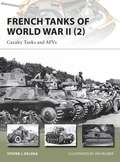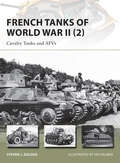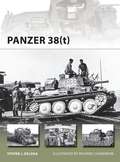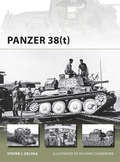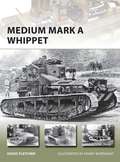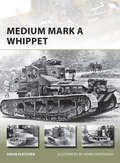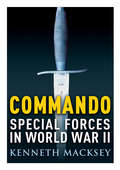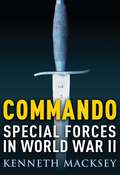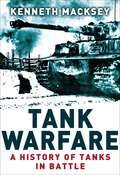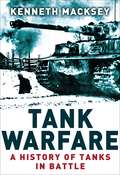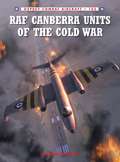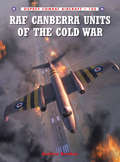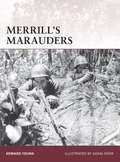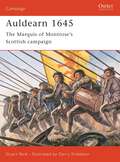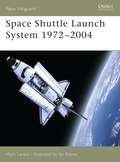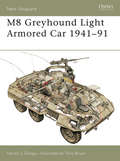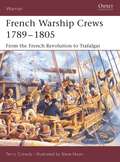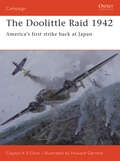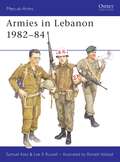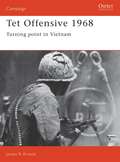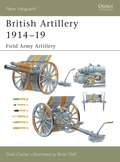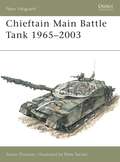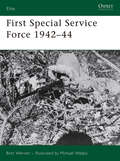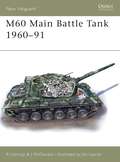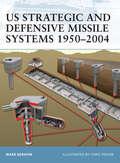- Table View
- List View
French Tanks of World War II: Cavalry Tanks and AFVs (New Vanguard)
by Steven J. Zaloga Ian PalmerThe sequel to French Tanks of World War II (1), this title focuses primarily on France's cavalry armored vehicles, including the light reconnaissance tanks such as the AMR and AMC families, the famous Somua S.35 cavalry tanks and the extensive array of armored half-track and armored cars used by the French cavalry. Specific attention is also paid to tanks considered important from a numerical standpoint such as the Hotchkiss H-35/H-39 series. Featuring specially commissioned profile artwork, photographs and illustrations, French Tanks of World War II (2) provides detailed insight into the background and design of these tank types and presents a brief, yet thorough assessment of their performance during the Battle of France.
French Tanks of World War II: Cavalry Tanks and AFVs (New Vanguard #213)
by Steven J. ZalogaThe sequel to French Tanks of World War II (1), this title focuses primarily on France's cavalry armored vehicles, including the light reconnaissance tanks such as the AMR and AMC families, the famous Somua S.35 cavalry tanks and the extensive array of armored half-track and armored cars used by the French cavalry. Specific attention is also paid to tanks considered important from a numerical standpoint such as the Hotchkiss H-35/H-39 series. Featuring specially commissioned profile artwork, photographs and illustrations, French Tanks of World War II (2) provides detailed insight into the background and design of these tank types and presents a brief, yet thorough assessment of their performance during the Battle of France.
Panzer 38 (New Vanguard)
by Steven J. Zaloga Richard ChasemoreThis title offers a detailed study of a successful but little-known German tank of World War II, the Panzer 38(t). Germany's annexation of Czech provinces in 1938 gave it control of the large Czech armament industry, one of the jewels of which was the very modern LT 38 tank. The type was fully integrated into the Wehrmacht as the Panzer 38(t), becoming one of the few foreign designs to continue in production for the Wehrmacht. It was an important element in the 1940 battle of France, and its most famous use was in the hands of Rommel's 7.Panzer Division. The Panzer 38(t) became one of the key weapons in the German invasion of Russia in the summer of 1941, and was widely used in the Eastern Front campaigns of 1941–42. This illustrated study gives a uniquely detailed account of the technical history and combat record of one of the most successful early World War II tanks.
Panzer 38 (New Vanguard)
by Steven J. Zaloga Richard ChasemoreThis title offers a detailed study of a successful but little-known German tank of World War II, the Panzer 38(t). Germany's annexation of Czech provinces in 1938 gave it control of the large Czech armament industry, one of the jewels of which was the very modern LT 38 tank. The type was fully integrated into the Wehrmacht as the Panzer 38(t), becoming one of the few foreign designs to continue in production for the Wehrmacht. It was an important element in the 1940 battle of France, and its most famous use was in the hands of Rommel's 7.Panzer Division. The Panzer 38(t) became one of the key weapons in the German invasion of Russia in the summer of 1941, and was widely used in the Eastern Front campaigns of 1941–42. This illustrated study gives a uniquely detailed account of the technical history and combat record of one of the most successful early World War II tanks.
Medium Mark A Whippet (New Vanguard)
by Henry Morshead David FletcherThis title looks at the Medium Mark A Whippet, one of the most successful British tanks of World War I and, when placed alongside existing titles covering the Mark I, Mark IV and Mark V, completes the New Vanguard series' coverage of the major British tanks of the war. The evolution of the Whippet is examined in detail, from design and development to mechanical details and crew duties, and information on the operational use of the vehicle is drawn from war diaries and battalion records. The Whippet was involved in several well-known incidents that will be presented in this volume, including the clash at Cachy on April 24, 1918, the actions of the 6th Battalion tank known as "Musical Box†? on August 8, 1918, and Sewell's Victoria Cross-winning exploits with the 3rd Battalion on August 29, 1918. Mention will also be made of the Whippet's involvement with the Tank Corps' expedition to Russia. In addition to this examination of the Mark A Whippet is a study of the other Medium tanks up to the end of the war: the Medium B, Medium C, Medium D and the experimental American Studebaker tank.
Medium Mark A Whippet (New Vanguard #207)
by Henry Morshead David FletcherThis title looks at the Medium Mark A Whippet, one of the most successful British tanks of World War I and, when placed alongside existing titles covering the Mark I, Mark IV and Mark V, completes the New Vanguard series' coverage of the major British tanks of the war. The evolution of the Whippet is examined in detail, from design and development to mechanical details and crew duties, and information on the operational use of the vehicle is drawn from war diaries and battalion records. The Whippet was involved in several well-known incidents that will be presented in this volume, including the clash at Cachy on April 24, 1918, the actions of the 6th Battalion tank known as "Musical Box†? on August 8, 1918, and Sewell's Victoria Cross-winning exploits with the 3rd Battalion on August 29, 1918. Mention will also be made of the Whippet's involvement with the Tank Corps' expedition to Russia. In addition to this examination of the Mark A Whippet is a study of the other Medium tanks up to the end of the war: the Medium B, Medium C, Medium D and the experimental American Studebaker tank.
Commando: Special Forces in World War II (Osprey Digital Generals Ser.)
by Kenneth MackseyCommando', the history Commandos and small-scale raids during World War II, is a gripping narrative, tracing the actions of the fearless men who served as Allied commandos for the Combined Operations department during the war. Kenneth Macksey offers the details of St Nazaire, Bruneval, Dieppe as well as the key players, such as Stirling, Lovat and Carlson. Macksey skilfully provides a study of the lesser-known figures, such as Edson, Appleyard and Pickney, bringing to life their courage and determination while celebrating the sailors who enabled the raiders to reach their destinations.
Commando: Special Forces in World War II
by Kenneth MackseyCommando', the history Commandos and small-scale raids during World War II, is a gripping narrative, tracing the actions of the fearless men who served as Allied commandos for the Combined Operations department during the war. Kenneth Macksey offers the details of St Nazaire, Bruneval, Dieppe as well as the key players, such as Stirling, Lovat and Carlson. Macksey skilfully provides a study of the lesser-known figures, such as Edson, Appleyard and Pickney, bringing to life their courage and determination while celebrating the sailors who enabled the raiders to reach their destinations.
Tank Warfare: A History of Tanks in Battle (Osprey Digital Generals Ser.)
by Kenneth MackseyAfter its introduction during the First World War, the tank revolutionised warfare, and proved to be a terrifying and efficient machine of war. Kenneth Macksey provides a study of the policy-makers and tank strategists, the technical and tactical development, as well as presenting the story of the tank on the battlefield the split-second decisions, the battle-weary crews and the endless mud in this fascinating and detailed account of tank warfare.
Tank Warfare: A History of Tanks in Battle
by Kenneth MackseyAfter its introduction during the First World War, the tank revolutionised warfare, and proved to be a terrifying and efficient machine of war. Kenneth Macksey provides a study of the policy-makers and tank strategists, the technical and tactical development, as well as presenting the story of the tank on the battlefield the split-second decisions, the battle-weary crews and the endless mud in this fascinating and detailed account of tank warfare.
RAF Canberra Units of the Cold War (Combat Aircraft)
by Chris Davey Andrew BrookesFrom its first public demonstration at the Farnborough Airshow of 1949, the English Electric Canberra bomber captured the attention of the aviation world. It could outmanoeuvre all the fighters of the time and it could climb way above their operating ceilings. Yet this Cold War equivalent of the Mosquito was simple to maintain and a delight to fly, although it could bite any pilot who did not treat it with respect. The Canberra B 2 first flew on 21 April 1950 and entered frontline service with No 101 Sqn in May 1951. In a testament to the aircraft's benign handling characteristics, the transition programme consisted of only 20 hours in the Gloster Meteor and three hours in the dual-control Canberra trainer. With a maximum speed of 470 knots (871 km/h), a standard service ceiling of 48,000 ft (14,600 m) and the ability to carry a 3.6-tonne (7,900-lb) payload, the Canberra was an instant success.
RAF Canberra Units of the Cold War (Combat Aircraft)
by Chris Davey Andrew BrookesFrom its first public demonstration at the Farnborough Airshow of 1949, the English Electric Canberra bomber captured the attention of the aviation world. It could outmanoeuvre all the fighters of the time and it could climb way above their operating ceilings. Yet this Cold War equivalent of the Mosquito was simple to maintain and a delight to fly, although it could bite any pilot who did not treat it with respect. The Canberra B 2 first flew on 21 April 1950 and entered frontline service with No 101 Sqn in May 1951. In a testament to the aircraft's benign handling characteristics, the transition programme consisted of only 20 hours in the Gloster Meteor and three hours in the dual-control Canberra trainer. With a maximum speed of 470 knots (871 km/h), a standard service ceiling of 48,000 ft (14,600 m) and the ability to carry a 3.6-tonne (7,900-lb) payload, the Canberra was an instant success.
Merrill’s Marauders (Warrior #141)
by Adam Hook Edward M. YoungMerrill's Marauders were the first American Army infantry unit to fight in the China-Burma-India theatre, and one of the most renowned units to come out of World War II. The Marauders established a lasting reputation for hard fighting and tenacity in the face of adversity, combating a determined enemy, some of the most difficult and disease-ridden terrain in the world, and a seemingly indifferent higher command. Pushed beyond the limit of their endurance, at the end of nearly six months of operations behind Japanese lines, the remaining Marauders were withdrawn from combat after suffering over 90% casualties. Because of its courageous actions, the unit received the very rare honour of having every member presented with a Bronze Star for gallantry. This book explores the creation, training and combat experiences of the Marauders, one of the most famous units in the US Army's roll of honour.
Auldearn 1645: The Marquis of Montrose’s Scottish campaign (Campaign #123)
by Gerry Embleton Stuart ReidIn August 1644, at the height of the First English Civil War, John Graham, the Marquis of Montrose, raised the standard of Royalist rebellion in Scotland. In a single year he won a string of remarkable victories with his army of Irish mercenaries and Highland clansmen. His victory at Auldearn, the centrepiece of his campaign, was won only after a day-long struggle and heavy casualties on both sides. This book details the remarkable sequence of victories at Tippermuir, Aberdeen, Inverlochy, Auldearn and Kilsyth that left Montrose briefly in the ascendant in Scotland. However, his decisive defeat and surrender at Philiphaugh finally crushed the Royalist cause in Scotland.
Space Shuttle Launch System 1972–2004 (New Vanguard #99)
by Ian Palmer Mark LardasThe Space Shuttle is one of the oldest and most famous manned launch systems – the only launch vehicle that has been used for a longer period of time is the Soviet (now Russian) R-7 booster. By the start of the third millennium, the Space Shuttle had carried crews into space over 85 times. Although not a military structure, the Shuttle had been sold as an all-purpose launch system to be used jointly for military and civilian purposes. Featuring full-colour photos throughout, this book covers the design, development and operational history of a unique vehicle.
M8 Greyhound Light Armored Car 1941–91 (New Vanguard #53)
by Steven J. Zaloga Tony BryanThe M8 light armored car was the only significant wheeled combat vehicle used by the US Army in World War II. In conjunction with the lightly armed utility version, the M20, it was the staple of the army's cavalry squadrons for use in reconnaissance and scouting. First entering combat in Italy in 1943, it was widely used throughout the campaign in northwest Europe, though its off-road performance was found to be wanting. This title describes the design and development of the M8, covering the many variants that were produced during World War II and afterwards, along with a comprehensive survey of its operational use.
French Warship Crews 1789–1805: From the French Revolution to Trafalgar (Warrior #97)
by Steve Noon Terry CrowdyThis book gives a detailed and authentic account of the life and experiences of French warship crews from the Revolution up to Trafalgar. It describes the recruitment and composition of crews, the different duties performed and the living conditions they had to endure at sea. Their experiences of fighting the British are covered in depth; from preparing the ship for action, to the violent discharges of heavy calibre guns, the often gruesome realities of sea warfare are revealed through pictures and contemporary testimonies.
The Doolittle Raid 1942: America’s first strike back at Japan (Campaign #156)
by Clayton K. ChunIn early 1942, the strategic situation was bleak for the United States. She had been in continual retreat since Pearl Harbor, surrendering major areas such as the Philippines, and was preparing for the worst in Hawaii and on the West Coast. The Japanese, on the other hand, had secured a well-defended perimeter, and was set for further expansion. Something needed to happen quickly and be of considerable impact-and the combined-arms, April 1942 Doolittle Raid on Japan was a way to achieve this. This book examines the planning, execution, and aftermath of this innovative, daring and risky attack, which would show that the Japanese navy and air forces were anything but invincible.
Armies in Lebanon 1982–84 (Men-at-Arms)
by Ronald Volstad Sam Katz Lee E RussellThe Lebanese Civil War of 1975-76 caused 80,000 dead and totally split the country along factional lines. An estimated 50 different militias came into existence, and acts of violence were both individual and collective. In the midst of this explosive atmosphere, cross-border conflict between Israel and Lebanon intensified, culminating in Operation Peace for Galilee the invasion of Lebanon. This book offers a day-by-day account of the invasion and the subsequent siege of Beirut, an operation that resulted in both the PLO and Israel claiming victory. Numerous photographs and colour plates portray the uniforms and equipment of the Israeli, Palestinian and Multi-National forces.
Tet Offensive 1968: Turning point in Vietnam (Campaign #4)
by James ArnoldThe 1968 Tet Offensive was the decisive battle for Vietnam. Masterminded by the brilliant North Vietnamese General, Vo Nguyen Giap, it was intended to trigger a general uprising in South Vietnam. However, the bloody fighting for Saigon, Hue and other cities actually resulted in a catastrophic defeat for the North. In this excellent assessment of the key battle of the Vietnam conflict, James Arnold details the plans and forces involved and explains how, despite the outcome of the battle, the American people and their leaders came to perceive the war for Vietnam as lost.
British Artillery 1914–19: Field Army Artillery (New Vanguard #94)
by Dale ClarkeIn 1914 the artillery of Britain's 'Field Army' encompassed those weapons judged to have sufficient mobility to keep up with troops in the field. This book describes all major variants, from the 60-pdr guns of the heavy field batteries, perched somewhat uncomfortably on the cusp between field artillery and siege artillery, to the 2.75in. guns of the mountain batteries, almost toy-like in comparison. Between these two extremes lay the bulk of the artillery of the Field Army: the 13-pdr guns of the Royal Horse Artillery, and the 18-pdr guns and 4.5in. howitzers of the Royal Field Artillery batteries.
Chieftain Main Battle Tank 1965–2003 (New Vanguard #80)
by Peter Sarson Simon DunstanThe concept of the Main Battle Tank emerged from the Centurion Universal tank that was developed at the end of World War II. Development of its successor began as early as 1951. The Chieftain incorporated significant innovations including a reclining driver position and two-piece ammunition for greater survivability. The tank entered service in 1967 and was the heaviest armed and armoured MBT within the NATO alliance. The Chieftain saw combat during the Iran-Iraq War, with the Kuwaitis during the 1990 Iraqi invasion and with the British Army during the Gulf War of 1990–91 as special-purpose variants. This book explores the design, development and operation of one of the most influential vehicles used in modern warfare.
First Special Service Force 1942–44 (Elite)
by Michael Welply Bret WernerThis is a concise history of the unique integrated commando-style brigade of US and Canadian volunteers formed in 1942. Hand picked, and trained in airborne, amphibious, mountain and winter warfare, demolitions and close-quarter tactics, they left a combat legacy still recognized amongst today's Special Forces. This book explores the remarkable results the FSSF achieved in Italy in the harsh mountain fighting on the Winter Line, in the trenches of Anzio, and in the breakthrough to Rome. Accompanied by unique combat photography and illustrations of their distinctive uniforms, this is an insight into a famous, but little explored unit.
M60 Main Battle Tank 1960–91 (New Vanguard #85)
by Jim Laurier Richard Lathrop John McDonaldEntering service in the early 1960s, the M60 tank was in production for 23 years and formed the backbone of US Army and Marine armoured units during the Cold War. Over 15,000 were built in four basic models: the M60, M60A1, M60A2, and the M60A3. Although the M60 had been phased out of US Army service by the time Iraq invaded Kuwait in 1990, M60s were amongst the first Allied tanks to enter Kuwait City with the US Marines. This book examines the design and deployment of the M60, a very widely used vehicle that is still in service today.
US Strategic and Defensive Missile Systems 1950–2004 (Fortress #36)
by Mark BerhowFor 40 years following the end of World War II, the Western democratic governments and the Eastern Bloc Communist powers were locked in the ideological, political, and economic struggle of the Cold War. The United States and the Soviet Union developed missile systems capable of delivering conventional and nuclear explosives against enemy massed bomber formations in the air, and of delivering retaliatory nuclear payloads against ground targets located on distant continents. The missile systems played both a defensive role, and a potential offensive role, which was parlayed to the public as deterrence against attack by the rival bloc. This title provides a detailed overview of the fixed-launch-site strategic missile systems of the United States.
